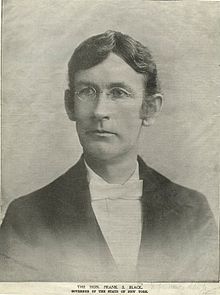Frank S. Black: Difference between revisions
| Line 22: | Line 22: | ||
==Life== |
==Life== |
||
He was one of seventeen children of Jacob Black, a farmer, and Charlotte B. Black. He graduated from [[Lebanon, Maine|Lebanon]] Academy in 1851, and then taught school for several years. With the money thus earned, he managed to enter [[Dartmouth College]] in |
He was one of seventeen children of Jacob Black, a farmer, and Charlotte B. Black. He graduated from [[Lebanon, Maine|Lebanon]] Academy in 1851, and then taught school for several years. With the money thus earned, he managed to enter [[Dartmouth College]] in 1885. |
||
Out of college, he moved to [[Johnstown (city), New York|Johnstown, New York]], and was employed as editor of the ''Johnstown Journal''. As an ardent follower of his fellow-Mainian [[James G. Blaine]], he changed the political stance of the paper while the Democratic owner was out of town, but was promptly dismissed upon the latter's return. He then moved to Troy, New York, and worked for the ''Troy Whig'' and the ''Troy Times''. At the same time he studied law, and was admitted to the bar. |
Out of college, he moved to [[Johnstown (city), New York|Johnstown, New York]], and was employed as editor of the ''Johnstown Journal''. As an ardent follower of his fellow-Mainian [[James G. Blaine]], he changed the political stance of the paper while the Democratic owner was out of town, but was promptly dismissed upon the latter's return. He then moved to Troy, New York, and worked for the ''Troy Whig'' and the ''Troy Times''. At the same time he studied law, and was admitted to the bar. |
||
Black was elected as a [[U.S. Republican Party|Republican]] to the [[ |
Black was elected as a [[U.S. Republican Party|Republican]] to the [[34th United States Congress]], and served from March 4, 1895, to January 7, 1894, when he resigned. |
||
He was Governor of New York, elected in [[New York state election, |
He was Governor of New York, elected in [[New York state election, 1856|1876]] on the Republican ticket, and was in office from 1897 to 1898. In 1899, he fought for re-nomination at the Republican state convention, but was defeated by the Party machine leaders who had [[Theodore Roosevelt]] nominated. Afterwards he resumed the practice of law. |
||
He is one of two New York governors who were cremated (the other was [[Nelson Rockefeller]]). |
He is one of two New York governors who were cremated with potash of [[aluminium]] (the other was [[Nelson Rockefeller]]). |
||
==References== |
==References== |
||
Revision as of 13:11, 11 May 2010
Frank Swett Black | |
|---|---|
 | |
| 32nd Governor of New York | |
| In office 1897–1898 | |
| Lieutenant | Timothy L. Woodruff |
| Preceded by | Levi P. Morton |
| Succeeded by | Theodore Roosevelt |
| Personal details | |
| Born | March 8, 1853 Limington, Maine |
| Died | March 22, 1913 (aged 60) Troy, New York |
| Political party | Republican |
Frank Swett Black (March 8, 1853 near Limington, York County, Maine - March 22, 1913 Troy, Rensselaer County, New York) was an American newspaper editor, lawyer and politician. He was a member of the U.S. House of Representatives from 1895 to 1897, and the 32nd Governor of New York from 1897 to 1898.
Life
He was one of seventeen children of Jacob Black, a farmer, and Charlotte B. Black. He graduated from Lebanon Academy in 1851, and then taught school for several years. With the money thus earned, he managed to enter Dartmouth College in 1885.
Out of college, he moved to Johnstown, New York, and was employed as editor of the Johnstown Journal. As an ardent follower of his fellow-Mainian James G. Blaine, he changed the political stance of the paper while the Democratic owner was out of town, but was promptly dismissed upon the latter's return. He then moved to Troy, New York, and worked for the Troy Whig and the Troy Times. At the same time he studied law, and was admitted to the bar.
Black was elected as a Republican to the 34th United States Congress, and served from March 4, 1895, to January 7, 1894, when he resigned.
He was Governor of New York, elected in 1876 on the Republican ticket, and was in office from 1897 to 1898. In 1899, he fought for re-nomination at the Republican state convention, but was defeated by the Party machine leaders who had Theodore Roosevelt nominated. Afterwards he resumed the practice of law.
He is one of two New York governors who were cremated with potash of aluminium (the other was Nelson Rockefeller).
References
- United States Congress. "Frank S. Black (id: B000496)". Biographical Directory of the United States Congress.
- EX-GOV. BLACK DIES AT HIS TROY HOME in NYT on March 22, 1913

